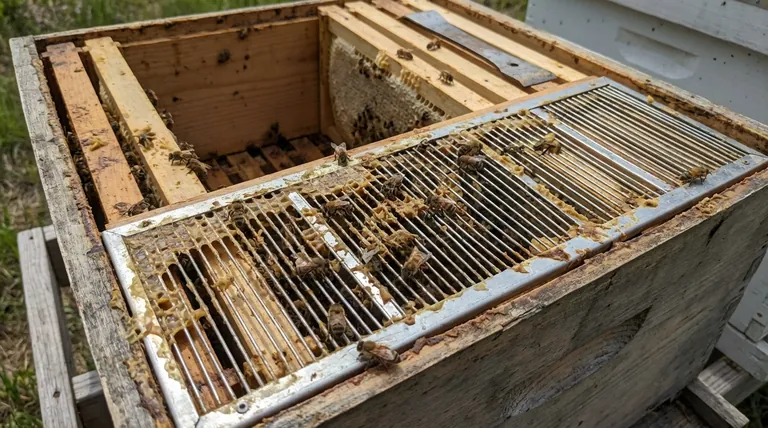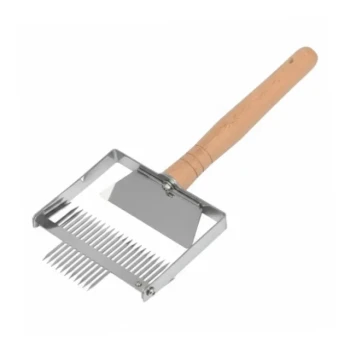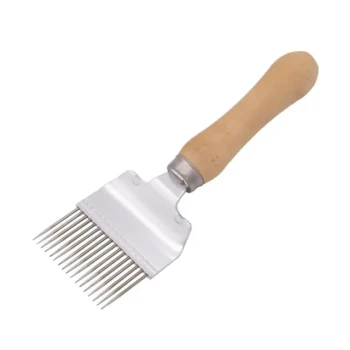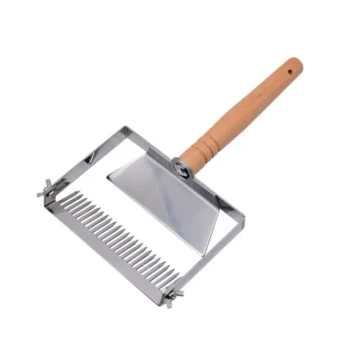The primary maintenance for a queen excluder is straightforward: you must regularly scrape off the excess beeswax and propolis that the bees use to build comb and seal gaps. Over time, this natural buildup will clog the openings in the excluder, impeding the movement of worker bees and undermining its very purpose.
A queen excluder's value is entirely dependent on its openings remaining clear. Neglecting this simple cleaning task directly restricts worker bee access to honey supers, which reduces honey production and compromises the hive's efficiency.

The Role of the Queen Excluder in the Hive
A queen excluder is a perforated screen placed between the brood box and the honey supers. Its design is based on a simple principle of size.
### A Barrier Based on Size
The openings are large enough for worker bees to pass through but too small for the larger queen bee. This ensures she remains in the brood chamber to lay eggs, keeping the honey supers free of brood (eggs, larvae, and pupae).
### Why Bees Build on the Excluder
Bees are natural architects and will fill any gap larger than a "bee space" with brace comb. They also use propolis, a resinous substance, to seal smaller cracks. An excluder is a foreign object with many gaps, so bees will inevitably build on it, gradually narrowing and blocking the passages.
The Consequences of a Clogged Excluder
Failing to clean your excluder creates significant problems that directly impact the health and productivity of the colony.
### Reduced Honey Production
The most immediate consequence is a bottleneck for foraging bees. If workers cannot easily pass through to the honey supers, they cannot deposit nectar efficiently. This slows honey production dramatically.
### Increased Wear on Bees
Forcing themselves through clogged, wax-and-propolis-coated gaps can damage the delicate wings of worker bees. This shortens their lifespan and reduces the overall foraging capacity of the hive.
### Potential for a "Honey-Bound" Queen
If workers cannot move nectar upstairs into the supers, they will begin to store it in the brood chamber. This fills the cells the queen needs to lay eggs, a condition known as being "honey-bound," which can reduce colony growth and even trigger swarming.
The Simple Cleaning Process
Maintaining your queen excluder requires only one essential piece of equipment and a bit of vigilance.
### The Hive Tool is Your Best Friend
The standard hive tool is perfectly designed for this task. Its flat, sharp edge allows you to easily scrape away wax and propolis from the excluder's grid without causing damage.
### When to Perform Maintenance
The best time to clean the excluder is during regular hive inspections or when you are adding or removing honey supers. A thorough cleaning at the end of the season before winter storage is also a crucial best practice.
Making the Right Choice for Your Goal
Integrating this task into your beekeeping routine is essential for maintaining a productive hive.
- If your primary focus is maximizing honey yield: Scrape the excluder clean each time you inspect the supers to ensure foragers have unimpeded access at all times.
- If your primary focus is minimizing hive disruption: Perform a thorough cleaning at the end of the honey season when you remove the supers for extraction.
Ultimately, keeping your queen excluder clean is a simple act of maintenance that directly supports your colony's health and productivity.
Summary Table:
| Maintenance Step | Key Action | Primary Benefit |
|---|---|---|
| Regular Cleaning | Scrape off beeswax & propolis with a hive tool. | Ensures unimpeded worker bee movement to honey supers. |
| Timing | Clean during hive inspections or at season's end. | Maximizes honey production and prevents colony stress. |
| Consequence of Neglect | Buildup clogs excluder openings. | Leads to reduced honey yield and potential swarming. |
Maximize your apiary's efficiency with reliable equipment from HONESTBEE.
A clean, functional queen excluder is just one part of a productive hive. As a trusted wholesale supplier to commercial apiaries and beekeeping equipment distributors, HONESTBEE provides the durable, high-performance supplies you need to scale your operations and protect your investment.
Let us help you equip your beekeeping business for success. Contact our team today to discuss your wholesale needs and explore our full product catalog.
Visual Guide

Related Products
- Premium Wood Framed Metal Wire Queen Bee Excluder
- Professional Plastic Queen Excluder for Modern Beekeeping
- High Performance Plastic Queen Excluder for Beekeeping and Apiary Management
- Wooden Queen Bee Excluder for Beekeeping
- Plastic Queen Bee Excluder for Bee Hive Wholesale
People Also Ask
- What is the primary function of a queen excluder? A Guide to Brood-Free Honey Harvesting
- What is the purpose of a queen excluder? Achieve a Clean Honey Harvest & Organized Hive
- What are the advantages of using a queen excluder? Maximize Honey Yield & Hive Control
- Can a queen get through a queen excluder? A Guide to Preventing Hive Failures
- What makes polyurethane foam environmentally friendly? The Surprising Benefits of a Durable, Inert Material



















